Photocurable Composition
A photocurable and composite technology, applied in optics, optomechanical equipment, nonlinear optics, etc., can solve the problems of liquid crystal display parts deformation, liquid crystal display is easy to produce strain, and material yield is low, and achieves the realization of fine lines. Easy to form, excellent in various characteristics, low light transmittance effect
- Summary
- Abstract
- Description
- Claims
- Application Information
AI Technical Summary
Problems solved by technology
Method used
Image
Examples
Embodiment
[0248] The following examples are given to illustrate the present invention more concretely. It goes without saying that these examples are merely illustrations and should not be interpreted limitedly.
Synthetic example 1
[0250] Polymer B1 having an acryloyloxy group was synthesized by the atom transfer radical method described later.
[0251] 100 parts of n-butyl acrylate were deoxidized. Deoxidize the inside of the reaction vessel, add 0.42 parts of cuprous bromide, 20 parts of deoxygenated n-butyl acrylate, 4.4 parts of acetonitrile, and 1.8 parts of diethyl 2,5-dibromoadipate, and mix at 80°C , adding 0.018 parts of pentamethyldiethylenetriamine (hereinafter referred to simply as triamine) to initiate a polymerization reaction. The remaining 80 parts of n-butyl acrylate were added in portions to carry out a polymerization reaction. During the polymerization, triamine was appropriately added to adjust the polymerization rate, and the polymerization was carried out while adjusting the internal temperature to about 80°C to about 90°C. When the monomer conversion rate (polymerization reaction rate) is about 95% or more, introduce oxygen-nitrogen mixed gas into the gas phase part of the reacti...
Synthetic example 2
[0253] Poly(n-butyl acrylate) polymer A1 having a dimethoxysilyl group was synthesized by the atom transfer radical method described later.
[0254] Under a nitrogen atmosphere, CuBr (1.09kg), acetonitrile (11.4kg), butyl acrylate (26.0kg) and 2,5-dibromoadipate (2.28kg) were added to a 250L reactor. Stir at ~80°C for about 30 minutes. Pentamethyldiethylenetriamine was added thereto to initiate the reaction. Thirty minutes after the start of the reaction, butyl acrylate (104 kg) was continuously added over 2 hours. During the reaction process, pentamethyldiethylenetriamine was added appropriately to change the internal temperature to 70°C to 90°C. The total amount of pentamethyldiethylenetriamine used so far was 220 g. After 4 hours from the start of the reaction, volatile components were removed by heating and stirring at 80° C. under reduced pressure. Acetonitrile (45.7 kg), 1,7-octadiene (14.0 kg), and pentamethyldiethylenetriamine (439 g) were added thereto, and stirri...
PUM
| Property | Measurement | Unit |
|---|---|---|
| The average particle size | aaaaa | aaaaa |
| Thickness | aaaaa | aaaaa |
| The average particle size | aaaaa | aaaaa |
Abstract
Description
Claims
Application Information
 Login to View More
Login to View More - R&D
- Intellectual Property
- Life Sciences
- Materials
- Tech Scout
- Unparalleled Data Quality
- Higher Quality Content
- 60% Fewer Hallucinations
Browse by: Latest US Patents, China's latest patents, Technical Efficacy Thesaurus, Application Domain, Technology Topic, Popular Technical Reports.
© 2025 PatSnap. All rights reserved.Legal|Privacy policy|Modern Slavery Act Transparency Statement|Sitemap|About US| Contact US: help@patsnap.com



